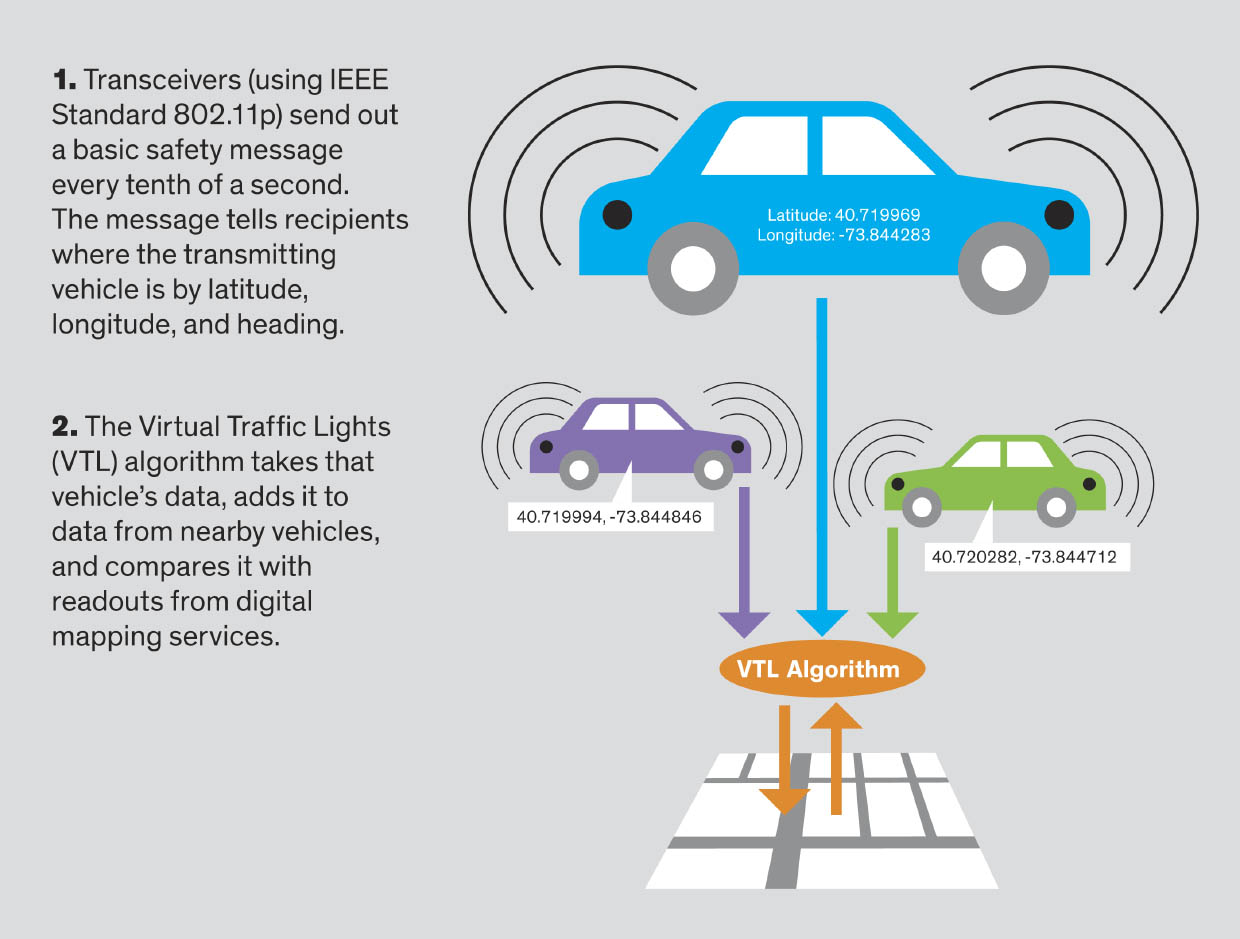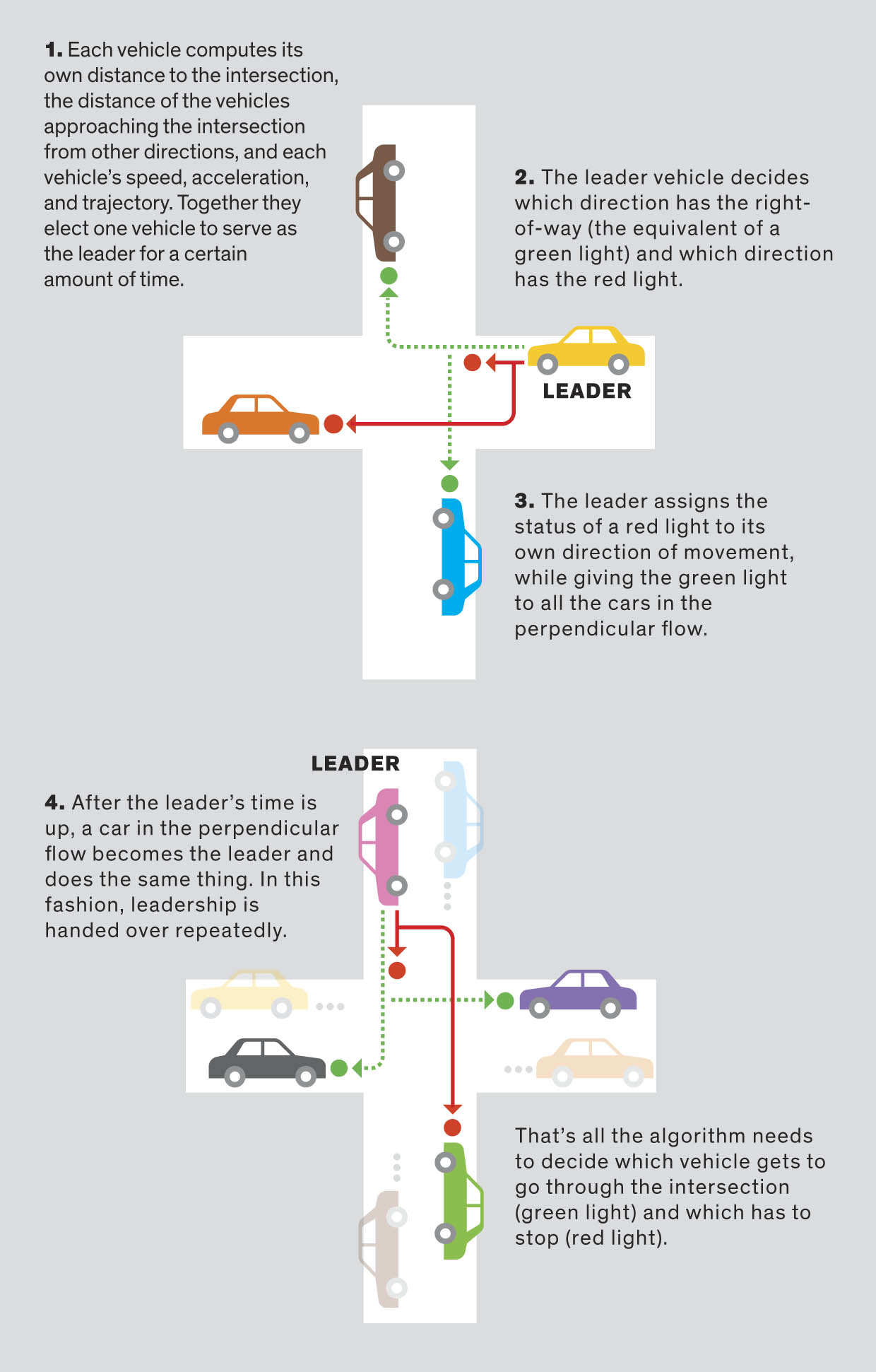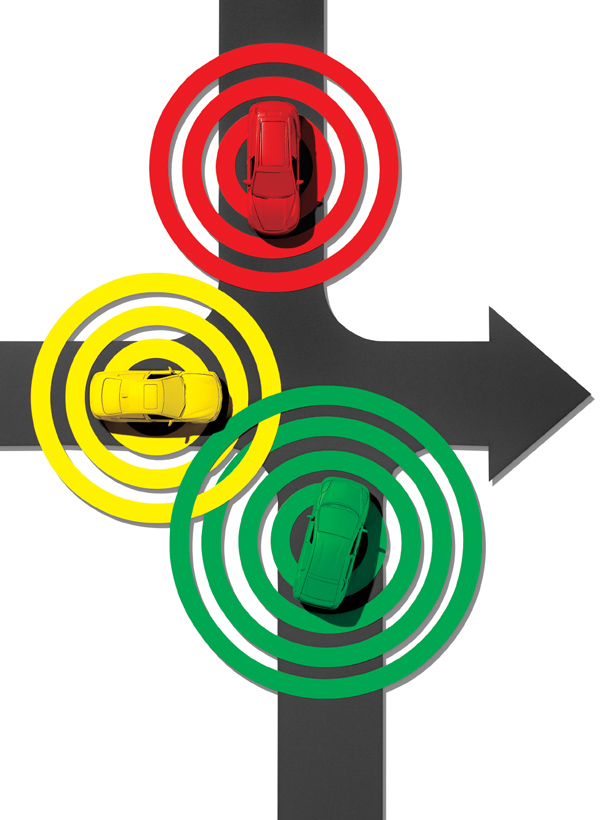How inter-transport communication can replace traffic lights and shorten the way to work
- Transfer
A startup from Carnegie Mellon University intends to control traffic at intersections using radio in cars of the future

Life is short, and in a traffic jam, it seems even shorter. Or when you are standing at a traffic light, it lights up red, and no one is going along the cross road.
Suburban residents of such cities as Mexico City, São Paulo, Rome, Moscow, Beijing, Cairo and Nairobi can go to work in the morning for two hours. Add here the way home from work, and it often happens that people spend 3-4 hours on the road every day.
Imagine that we could develop a system that would reduce the daily way back and forth, say, by a third - from three to two hours. It can save 22 hours per month, or 3 years for a 35-year career.
Take heart, unhappy travelers to and from work, because such a system is already being developed, and it is based on several recent technologies. One of them is wireless communication between cars. It is often called the V2V (vehicle-to-vehicle) technology, although this connection may also include road signals and other infrastructure. Another emerging technology is robomobils, which by their nature should reduce the time of commuting (and make this time more productive). And then there is the Internet of Things (IoT), which promises to combine not just 7 billion people, but also 30 billion sensors and devices.
All these technologies can be made to work together using the algorithm that my colleagues and I developed at Carnegie Mellon University in Pittsburgh. The algorithm allows automobiles to work together using the messaging systems they have on board, so that the vehicles move smoothly and safely without the use of any traffic lights. For this project, we registered the company Virtual Traffic Lights [virtual traffic lights] (VTL), carefully checked the algorithm in the simulations, and since May 2017 this project has been operating near the university campus. In July, for the first time, we demonstrated to the public the technology of VTL in Saudi Arabia, where more than 100 scientists, government officials and representatives of private companies were present.
The test results confirmed what we already suspected: it’s time to abandon traffic lights. We have nothing to lose but countless hours of sitting in a car in traffic.
The principle of operation of the traffic light has hardly changed since it was invented in 1912 and introduced in Salt Lake City, and two years later in Cleveland [ it should be clarified that this is the first electric traffic light. The first device with a manual drive came up in London in the XIX century / approx. trans. ]. It works on a timer, so sometimes you stand on the red at the intersection, and you do not see other cars nearby. the timer can be adjusted to match the patterns of movement at different times of the day, but this is almost all that can be done - and this is not so much [here the authors are cunning - for a long time there are automatic traffic control systems with cameras that capture traffic, as well as remote traffic control systems from the center, where people watch the traffic congestion / approx. trans. ]. As a result, a lot of people spend a lot of time every day.
Imagine that instead of this several cars drive up to the intersection, exchanging data thanks to V2V technology. They jointly vote and choose a leading car for a certain period, in which it decides which direction to become the main one - the equivalent of green light - and in which direction the “red light shines”.

IEEE 802.11p transceivers send messages 10 times per second. The message indicates the coordinates of the machine and the direction of movement.
The algorithm takes data, adds it to the data of other machines, and compares it with digital maps.
And who has the main road? Everything happens very simply and with respect. The leader assigns a red light status to his driving direction, and gives the green light to all cars traveling perpendicularly. After, say, 30 seconds, another machine, in a perpendicular flow, becomes the leader, and does the same. Leadership is constantly being transferred back and forth to honestly share responsibility and burden - after all, the position of the leader is connected with the sacrifice of personal interests for the common good.
With this approach, no traffic lights are needed. Traffic control work is quietly dissolved in a wireless infrastructure. You will no longer be sitting in the car, standing at the red signal of the traffic light, if no one is driving along the cross street.
Our VTL algorithm selects leaders, polling parameters such as the distance to the front car from each driveway to the intersection, the speed of the cars, the number of cars on each of the roads, etc. Other things being equal, the algorithm chooses the car furthest from the intersection so that it has time to brake. This rule ensures that the vehicle closest to the intersection will receive the right of way - that is, a virtual green light.
It is important to note that the technology does not need cameras, radar and lidar. It receives all information from wireless systems operating on dedicated short-range communications ( DSRC ). These are radio circuits and a dedicated communication channel developed in the USA, Europe and Japan from 1999 to 2008, and allowing nearby vehicles to communicate with each other. The DSRC developers assumed various options for using the standard, including raising money for using toll roads and cooperative adaptive cruise control — as well as precisely the function for which we use it to avoid collisions at intersections.
From the factory, the DSRC system is put on a small number of cars (and, perhaps, the new 5G technology will come to replace it). But such transceivers can be bought , and they have all the functionality we need. They use the IEEE Standard 802.11p standard and are required to send messages ten times per second. The message indicates the coordinates and direction of the vehicle. Our algorithm, working on the car's computer, receives data on the car, adds those that it receives from its neighbors, and superimposes the result on digital maps such as Google Maps, Apple Maps or OpenStreetMap.
In this way, each machine can calculate the distance to the intersection and to other machines approaching it from other directions. It can also calculate the speed, acceleration and trajectory of each of the machines. And this is all the algorithm needs to decide who will drive through the intersection (green light) and who needs to stop (red). After that, the dashboard of each car will show the color of the traffic light, its own for each driver. Of course, the VTL algorithm solves only the problem of traffic control at intersections, the definition of the signs "stop" and "give way." He doesn't drive a car. But working in its field, VTL is able to do everything that is needed, and is much cheaper than fully autonomous car technology. Robotic cars require much more computational power just to figure out the data coming from their lidars, radars, cameras and other sensors, and even more so that, having combined them, to get a picture of the surrounding space. VTL does not compete with robotic technology, it complements them.
Our method can be imagined as a replacement of the practical rule with true intellect. The algorithm allows the machines themselves to control the traffic, as it works in colonies of insects and schools of fish. A flock of fish changes direction at the same time, without any chief regulator directing its individual members. Each fish receives information about movements from its neighbors.
This is an example of the behavior of a distributed system as an alternative to a centralized network. With its help, a car park in the city can independently regulate traffic without centralized control and human intervention - no police, traffic lights, “stop” and “give way” signs.
We have not invented the concept of smart crossings, it has been around for several decades. One of the early ideas was to install magnetic coils under the asphalt surface, which would determine the approach of the machines to the intersection and correct the duration of the green and red phases. You can also use cameras at intersections to calculate the approaching cars and calculate the best time for the phases of the traffic light. But both technologies are expensive to install and maintain, and therefore installed at a few intersections.
We began by introducing the VTL algorithm in the virtual models of two cities: Pittsburgh in the USA and Porto in Portugal. We took the traffic data from the US Census Bureau and the relevant Portuguese agency, added maps from Google Maps, and fed it all to SUMO ( Simulation of Urban Mobility, city traffic simulator) - open source software developed in the German Aerospace Center.
SUMO simulated rush hour in two scenarios - one used the existing traffic lights, the other - our VTL algorithm. VTL was found to reduce the average travel time from 35 minutes to 21.3 minutes in Porto and from 30.7 minutes to 18.3 minutes in Pittsburgh. Reducing the travel time of people entering the city from the suburbs, decreased by no less than 30%, and up to 60%. What is important, the variation in travel time — the amount deviation from the mean — also decreased.

Leader selection scheme
Time is saved for two reasons. First, VTL eliminates waiting time at a red traffic light when no one is driving along a cross road. Secondly, VTL controls movement at all intersections, and not only where there are active signals. Therefore, the machines did not have to, for example, stop where the stop sign stands, if there were no other cars nearby.
Our simulations have demonstrated other benefits - perhaps even more important than time savings. The number of traffic accidents decreased by 70%, and for the most part the reductions occurred at intersections and at the stop signs. Also, by minimizing the time spent standing in front of a traffic light, accelerating and braking, VTL significantly reduces carbon emissions from cars.
What is required to transfer the VTL from the laboratory to the real world? First you need to build in the DSRC produced cars. In 2014, the US National Highway Traffic Safety Administration offered to use this technology, but the Trump administration has not yet developed the relevant rules, and it is not yet clear what the final solution will be. Therefore, manufacturers in the United States will reluctantly build DSRC transceivers into cars, as they increase their value and will be useful only if other machines have them — standard chicken and egg problems.
Until a sufficient number of machines is equipped with such devices, the scale of production will remain low and the cost will be high. In the US, only General Motors began building DSRC radios in cars, and all of them are expensive Cadillac models. However, in Europe and Japan, the picture is more positive. Many European automakers have decided to build these transceivers into cars, and this year it began in Japan, where the government is in favor of using technology, and the manufacturing giant Toyota has repeatedly confirmed its readiness for this step.

But even if nothing happens with DSRC, our algorithm can be built on the basis of other wireless technologies, for example, 5G or Wi-Fi.
The concept of transceiver incomplete penetration raises the question of one of the biggest obstacles to implementing VTL. Can it work if only a small percentage of machines are equipped with transmitters? Yes, if the officials decide to equip the existing traffic lights with this technology.
Officials may want to do this, if only then, so as not to abandon the existing infrastructure worth hundreds of billions of dollars. We offer a short-term solution to this problem: you can update the existing traffic lights so that they can recognize the presence of cars equipped with DSRC on the road, and accordingly exhibit the green and red phases. The beauty of this scheme is that all cars can use roads and intersections, regardless of the presence of the radio. This approach may not reduce time as significantly as the ideal solution, but it will still be 23% better than current traffic management systems, according to our simulations and field trials in Pittsburgh.
Another problem is how to deal with pedestrians and cyclists. Even if you forcefully equip all cars and trucks with transceivers, one cannot expect that the cyclists will put them for themselves and carry pedestrians with them. Because of this, it will be difficult for people to safely cross loaded intersections.
Our short-term solution, for the period of the coexistence of traffic lights and VTL, is to give pedestrians the opportunity to arrange a main road for themselves. In our pilot program in Pittsburgh, we placed a button that lit a red light — real for pedestrians, and virtual for cars — on all four sides of the intersection. This system worked every time it was activated.
In the long run, the problems of cyclists and pedestrians can be solved with the help of the Internet of things. With the expansion of IoT, the time will come when everyone will constantly carry around a device that supports DSRC.
In the meantime, we have demonstrated that under ideal conditions, without any physical signals, cars voting for the right of way can allocate part of the cycle to pedestrians. During switching, the virtual red light is on in all vehicles at all entrances to the intersection, and lasts long enough for pedestrians to safely cross the road. This preliminary decision will not be optimal for a dense stream, therefore we are working on a method using inexpensive cameras mounted on the dashboard of machines that should help to notice and give way to pedestrians.
The promising technology of virtual traffic lights makes the approach of the era of mobiles. Today we imagine that such cars will do everything that people drivers do: stop at traffic lights, give way to signs “give way”, and so on. But why make automation half? It would be much better if such machines completely autonomously controlled the movement without the usual signs and signals. The key to achieving this is V2V and the infrastructure of these communications.
This is important because today's robomobils often fail to navigate and drive through busy intersections. This is one of the most difficult technical problems, and it continues to pester even the industry leader Waymo.
In our simulations and field tests, we found that robomobils equipped with a VTL can control the intersection of intersections without traffic lights and signs. The absence of the need to recognize these objects seriously simplifies the computer vision algorithms and the computers that execute them, which are relied on by today's experimental ro-mobili. These elements in total, together with sensors (especially lidars), represent the most expensive part of robots.
Since the software architecture of the VTL is modular, it will be sufficient to simply integrate it into the robo mobile software. Moreover, VTL is capable of solving most, if not all, of the most complex problems associated with computer vision - let’s say if the sun shines into the camera, or rain, snow, sandstorm or road bends block the view. VTL, of course, does not compete with robotic technology; she complements them. And this alone can help accelerate the withdrawal of Robo vehicles to the roads.
But we hope that long before this moment our system will work in machines that are driven by people. Already this July, we were able to arrange a public demonstration of technology in the city of Riyadh in Saudi Arabia, with a heat of 43 ° C, with devices installed on test machines. Representatives of the government, scientists and corporations — including Uber — took the Mercedes-Benz bus and drove around King Abdulaziz’s science and technology campus, crossing three intersections, two of which had no traffic lights. The bus, as well as the GMC truck, the Hyundai SUV and the Citroën passenger car, crossed these intersections in every possible way, and the VTL system worked successfully every time. When one driver did not specifically obey the red signal of the traffic light and tried to drive through the intersection, our security system worked
I hope that this moment was a turning point in our transport management system. Traffic lights worked their way. And indeed, they existed for over a hundred years. It's time to move on.
